England Train Station
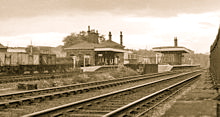
The Hundred of Hoo Railway Story. Opening Sequence Gravesend & Hoo Junction
Documentary about the old Hundred of Hoo branch line in Kent. Photography was started in 1994 but film was not completed untill 2005. Camera: Arriflex ST Filmstock: Kodak 16mm Eastmancolor Negative.
Broad Green station, Liverpool, shown in 1962, opened in 1830, is the oldest used station in the world.
A train station, also referred to as a railway station (in most forms of English including British English,Australian English, Indian English, etc.) or a railroad station (in US English) and often shortened to juststation, is a railway facility where trains regularly stop to load or unload passengers and/or freight. It generally consists of a platform next to the track and a station building (depot) providing related services such as ticket sales and waiting rooms. If a station is on a single track main line, it often has a passing loop to facilitate the traffic. The smallest stations are most often referred to as ‘stops’ or, in some parts of the world, as ‘halts’ (flag stops).
Stations may be at ground level, underground, or elevated. Connections may be available to intersecting rail lines or other transport modes such as buses, trams or other rapid transit systems.
Development
 The grand Retiro railway station inBuenos Aires, 1915, was the largest station in the world at the time. The station’s steel frame was made in Liverpool in England and shipped to Argentina.
The grand Retiro railway station inBuenos Aires, 1915, was the largest station in the world at the time. The station’s steel frame was made in Liverpool in England and shipped to Argentina.
 Liverpool Lime Street Station is fronted by a chateau.
Liverpool Lime Street Station is fronted by a chateau.
The Vitebsky station in Saint Petersburg, an example of a grand Russian terminal.
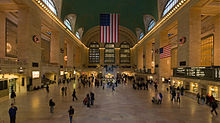 Grand Central Terminal in New York City is the world’s largest station by number of platforms, having 67 tracks on two levels.
Grand Central Terminal in New York City is the world’s largest station by number of platforms, having 67 tracks on two levels.
The world’s first railway station was probably built for the Swansea and Mumbles Railway, which began passenger service in 1807. The world’s oldest station built for steam locomotives which is still in use is Broad Green railway station in Liverpool, England, which was built in 1830 and is on the Liverpool to Manchester Line. The world’s oldest terminal station was Crown Street railway station in Liverpool, built in 1830, also on the Liverpool to Manchester line. The station was the first to incorporate a train shed. The station was demolished in 1836 as the Liverpool terminal station moved to Lime Street railway station. The station was converted to a goods station terminal.
The first stations had little in the way of buildings or amenities. The first stations in the modern sense were on the Liverpool and Manchester Railway, opened in 1830.[2] As of 2008, Manchester’s Liverpool Road Station is preserved as part of the Museum of Science and Industry in Manchester. It resembles a row of Georgian houses. Early stations were sometimes built with both passenger and goods facilities, though some railway lines were goods-only or passenger-only, and if a line was dual-purpose there would often be a goods depot apart from the passenger station.
Dual-purpose stations can sometimes still be found today, though in many cases goods facilities are restricted to major stations. In rural and remote communities across Canada and the United States, passengers wanting to board the train had to flag the train down in order for it to stop. Such stations were known as “flag stops” or “flag stations.”
Many stations date from the 19th century and reflect the grandiose architecture of the time, lending prestige to the city as well as to railway operations. Countries where railways arrived later may still have such architecture, as later stations often imitated 19th-century styles. Various forms of architecture have been used in the construction of stations, from those boasting grand, intricate, Baroque– or Gothic-style edifices, to plainer utilitarian or modernist styles. Stations in Europe tended to follow British designs and were in some countries, like Italy, financed by British railway companies.
Stations built more recently often have a similar feel to airports, with a simple, abstract style. Examples of modern stations include those on newer high-speed rail networks, such as the Shinkansen in Japan, TGV lines in France and ICE lines in Germany.
Station facilities
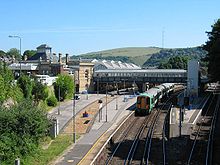 The typical non-terminus Lewes railway station in East Sussex, United Kingdom. Passengers reach the island platform (on right) by a pedestrian footbridge. Two further platforms are out of view.
The typical non-terminus Lewes railway station in East Sussex, United Kingdom. Passengers reach the island platform (on right) by a pedestrian footbridge. Two further platforms are out of view.
Stations usually have staffed ticket sales offices, automated ticket machines, or both, although on some lines tickets are sold on board the trains. Many stations include a shop or convenience store. Larger stations usually have fast-food or restaurant facilities. In some countries, stations may also have a bar or pub. Other station facilities may include: toilets, left-luggage, lost-and-found, departures and arrivals boards, luggage carts, waiting rooms, taxi ranks and bus bays. Larger or manned stations tend to have a greater range of facilities. A basic station might only have platforms, though it may still be distinguished from a halt, a stopping or halting place that may not even have platforms.
In many African and South American countries, and in many places in India, stations are used as a place for public markets and other informal businesses. This is especially true on tourist routes or stations near tourist destinations.
As well as providing services for passengers and loading facilities for goods, stations can sometimes have locomotive and rolling stock depots (usually with facilities for storing and refuelling rolling stock and carrying out minor repair jobs).
Configurations of stations – Railway station layout
In addition to the basic configuration of a station, various features set certain types of station apart. The first is the level of the tracks. Stations are often sited where a road crosses the railway: unless the crossing is a level crossing, the road and railway will be at different levels. The platforms will often be raised or lowered relative to the station entrance: the station buildings may be on either level, or both. The other arrangement, where the station entrance and platforms are on the same level, is also common, but is perhaps rarer in urban areas, except when the station is a terminus. Elevated stations are more common, not including metro stations. Stations located at level crossings can be problematic if the train blocks the roadway while it stops, causing road traffic to wait for an extended period of time.
Occasionally a station serves two or more railway lines at differing levels. This may be due to the station’s position at a point where two lines cross (example: Berlin Hauptbahnhof), or may be to provide separate station capacity for two types of service, e.g. intercity and suburban (examples: Paris-Gare de Lyon and Philadelphia’s 30th Street Station), or for two different destinations.
Stations may also be classified according to the layout of the platforms. Apart from single-track lines, the most basic arrangement is a pair of tracks for the two directions; there is then a basic choice of an island platform between, or two separate platforms outside, the tracks. With more tracks, the possibilities expand.
Some stations have unusual platform layouts due to space constraints of the station location, or the alignment of the tracks. Examples include staggered platforms, such as at Tutbury and Hatton railway station on the Derby – Crewe line, and curved platforms, such as Cheadle Hulme railway station on the Macclesfield to Manchester Line.Triangular stations also exist where two lines form a three-way junction and platforms are built on all three sides.
Terminus
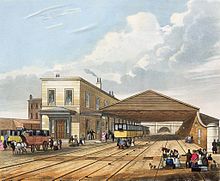 Opened in 1830 and reached through a tunnel, Liverpool’s Crown Street railway station was the first ever railway terminus. The station was demolished after only six years being replaced by Lime Street Stationin the city centre. The tunnel still exists.
Opened in 1830 and reached through a tunnel, Liverpool’s Crown Street railway station was the first ever railway terminus. The station was demolished after only six years being replaced by Lime Street Stationin the city centre. The tunnel still exists.
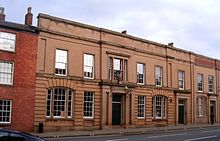 Opened in 1830, Liverpool Road stationin Manchester is the oldest surviving railway terminus building in the world.
Opened in 1830, Liverpool Road stationin Manchester is the oldest surviving railway terminus building in the world.
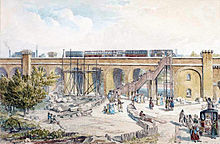 Opened in 1836, Spa Road railway station in London was the city’s first terminus and also the world’s first elevated station and terminus.
Opened in 1836, Spa Road railway station in London was the city’s first terminus and also the world’s first elevated station and terminus.
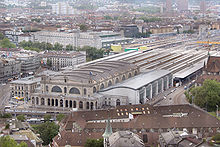 Aerial view of the Hauptbahnhof (Main Station) in Zurich, Switzerland; As well as being a terminus, the station now has underground S-Bahn platforms serving a newer line that runs beneath the city centre.
Aerial view of the Hauptbahnhof (Main Station) in Zurich, Switzerland; As well as being a terminus, the station now has underground S-Bahn platforms serving a newer line that runs beneath the city centre.
A “terminal” or “terminus” is a station at the end of a railway line. Trains arriving there have to end their journeys (terminate) or reverse out of the station. Depending on the layout of the station, this usually permits travellers to reach all the platforms without the need to cross any tracks – the public entrance to the station and the main reception facilities being at the far end of the platforms.
Sometimes, however, the track continues for a short distance beyond the station, and terminating trains continue forwards after depositing their passengers, before either proceeding to sidings or reversing to the station to pick up departing passengers. Bondi Junction is like this.
Many terminus stations have underground rapid-transit urban rail stations beneath, to transit passengers to the local city or district.
A terminus is frequently, but not always, the final destination of trains arriving at the station. However a number of cities, especially in continental Europe, have a terminus as their main railway stations, and all main lines converge on this station. There may also be a bypass line, used by freight trains that do not need to stop at the main station. In such cases all trains passing through that main station must leave in the reverse direction from that of their arrival. There are several ways in which this can be accomplished:
- arranging for the service to be provided by amultiple-unit or push-pull train, both of which are capable of operating in either direction; the driver simply walks to the other end of the train and takes control from the other cab; this is increasingly the normal method in Europe;
- by detaching the locomotive which brought the train into the station and then either
- using another track to “run it around” to the other end of the train, to which it then re-attaches;
- attaching a second locomotive to the outbound end of the train; or
- by the use of a “wye“, a roughly triangular arrangement of track and switches (points) where a train can reverse direction and back into the terminal.
Some former termini have a newer set of through platforms underneath (or above, or alongside) the terminal platforms on the main level. They are used by a cross-city extension of the main line, often for commuter trains, while the terminal platforms may serve long-distance services. Examples of underground through lines include theThameslink platforms at St. Pancras in London, the Argyle and North Clyde lines of Glasgow’s suburban rail network, the recently built Malmö City Tunnel, in Antwerp in Belgium, the RER at the Gare du Nord in Paris, and many of the numerous S-Bahn lines at terminal stations in Germany, Austria and Switzerland, such as at Zurich Hauptbahnhof.
An American example of a terminal with this feature is Washington, DC‘s Union Station, where there are higher-level platforms, Gates A through G serving the terminating trains, such as some Northeast Regionals, the Vermonter and all Acela Expresses. Some other Northeast Regional trains and Atlantic Coast service trains use lower-level platforms, Gates H through L (there is no Gate I), that tunnel right under the station concourse and continue to Virginia and beyond. Auto Train uses Lorton, Virginia Station for three primary reasons:
- the tri-level auto racks used to carry the cars are too tall to fit in the tunnels;
- the platforms would be too short to accommodate the 30-60 coach trainset;
- there is not enough room and there are too many tracks, trains, buildings and people around, so loading cars would be quite tricky.
Terminus stations in large cities are by far the biggest stations, with the largest being the Grand Central Terminal in New York City, United States. Often major cities, such as London, Boston, Paris, Istanbul, Tokyo and Milan have more than one terminus, rather than routes straight through the city. Train journeys through such cities often require alternative transport (metro, bus, taxi or ferry) from one terminus to the other. For instance in Istanbul transfers from the Sirkeci Terminal (the European terminus) and the Haydarpaşa Terminal (the Asian terminus) requires crossing the Bosphorus via alternative means. Though some cities, including New York, have both termini and through lines.
Terminals that have competing rail lines using the station frequently set up a jointly owned terminal railroad to own and operate the station and its associated tracks and switching operations.



